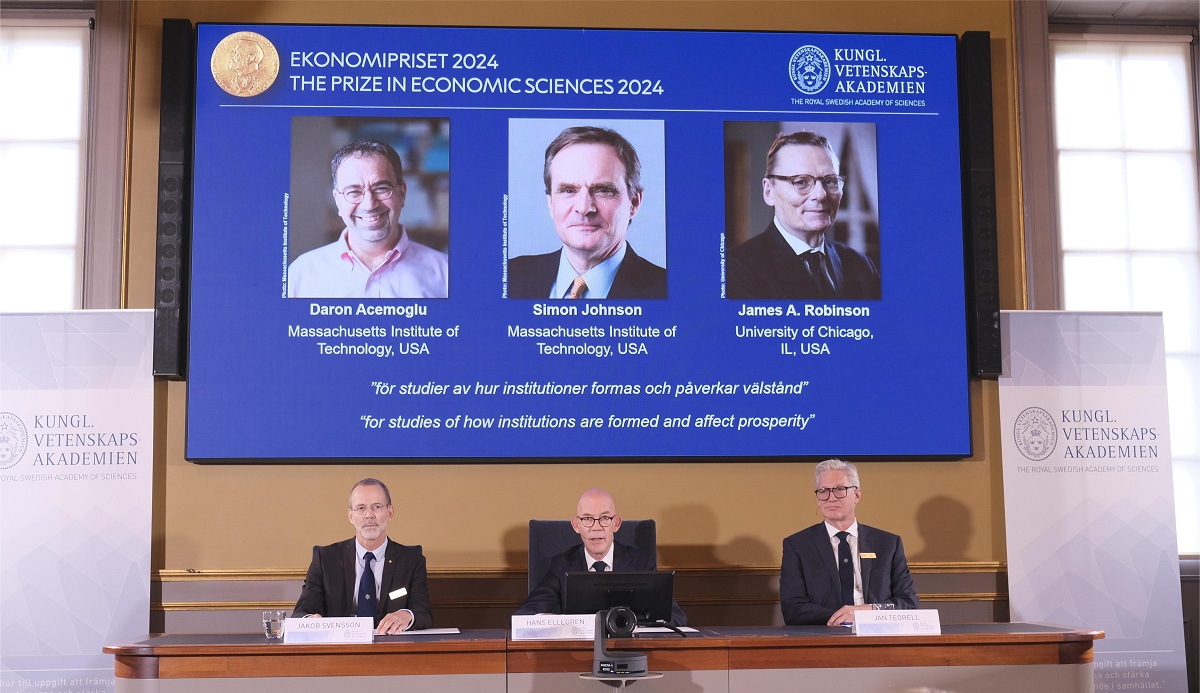Why are some countries rich and others poor? Finding the answer to this vital question would deserve a Nobel Prize. Indeed, that is the motivation of this year’s economic award, awarded to Acemoglu, Johnson and Robinson (AJR), with most of the credit going to Daron Acemoglu. His decades-long research has focused on the causal role of institutions in economic development.
To argue that institutions are important in economic growth is hardly new, and in fact Douglass North received the Nobel 30 years ago for his work on this topic. But why have some countries had, or developed, good institutions while others have not? AJR argue that the process of colonisation provides an answer.
These “inclusive” institutions differentiated one set of colonies from those where the colonists were interested only in exploiting the natural resources.
Where the colonists established substantial settlements, they brought their developed institutions with them – property rights, the rule of law, and usually some form of representative government. The United States, Canada, Australia and New Zealand are examples. These “inclusive” institutions differentiated one set of colonies from those where the colonists were interested only in exploiting the natural resources. Africa provides case studies.
AJR go one step further in this chain of causation. They argue that the key characteristic of these exploitative colonies, with their undeveloped institutions, was that the colonists did not establish substantial settlements because the local climate posed too great a health risk. This might make sense as one among the many causal factors in the multi-faceted story of development (and colonialism). But it is too frail a structure to explain the central issues of development, international inequality and institutional development.

They back their theory with an econometric gimmick – instrument variables – to address the central (and insurmountable) problem of establishing clear causation. Yes, it’s quite possible that richer countries have better institutions because they are rich, rather than the other way round. So, they allow for this possibility by searching among the many correlated factors that impinge on economic development for one that couldn’t possibly be a cause of development, and use this in their key regressions. Death rates among colonisers is the chosen instrument variable. Having excluded from the regressions all other possible explanations of development on the grounds of possible reverse-causation, death rates perform well, at least statistically, to explain different levels of GDP across a variety of successful and less-successful colonies. Excluding all the other possible drivers of development might solve the econometric problem, but not pass the test of common sense.
It may be that the AJR explanation fits some of the African countries, but counter-examples elsewhere abound. In Asia, Japan initiated its own transformation in the 19th century by importing know-how and institutions from Western countries. Earlier still, China had periods of enormous self-generated dynamism. Nor does the AJR view of the colonial process fit the 19th-century colonial competition in China, or Japan’s colonising experience in Korea and Taiwan.
There is a strong political message running through this story: “inclusive” institutions are synonymous with democracy. But this linkage lacks universality.
The stunning development success stories of the post-Second World War era – Japan, Taiwan, Hong Kong, Singapore and, later, China, Vietnam and the whole of Southeast Asia – don’t seem to have much to do with the institutional legacy of colonialism. Nor, for that matter, does the AJR story fit with the evolution of colonial experience. Indonesia, for example, had few settlers in its early colonial years, because the spice trade needed only a small number of expatriates, but the later plantation economy involved a quarter of a million Dutch settlers, without this evolution changing the domestic institutional structure in the way envisaged by AJR. Where does India fit in their theory?
Some might argue that the substantial colonial settlements of America, Canada, Australia and New Zealand happened because the indigenous populations could be displaced fairly easily.
There is a strong political message running through this story: “inclusive” institutions are synonymous with democracy – a message that finds favour with those promoting Western liberal values (including the Nobel committee?). But this linkage lacks universality. China’s stunning economic success came within an authoritarian regime. India’s long-established democratic processes did little to promote economic development in the first four decades of independence. In both these cases, market-based economics is a more powerful explanator.
But perhaps it is too harsh to condemn the researchers (and the Nobel decision-makers) on technical grounds or for a lack of universality in a theory. If AJR are judged on their wider contribution to economic methodology, the prize is deserved. In a world where mainstream academic economics has largely gone down a mathematical dead-end, those economists who are attempting to resurrect or construct a more useful kind of economics, based on close observation of the real world, deserve recognition. AJR represent those economists who see economics as more akin to history – searching in past experience for greater understanding of how the world works, drawing on the techniques of all the social sciences (although not without controversy). Closely related, others are gathering and analysing data at the micro level – recognised in the award of the prize in 2019 for the “experimental approach to eliminating global poverty”.

